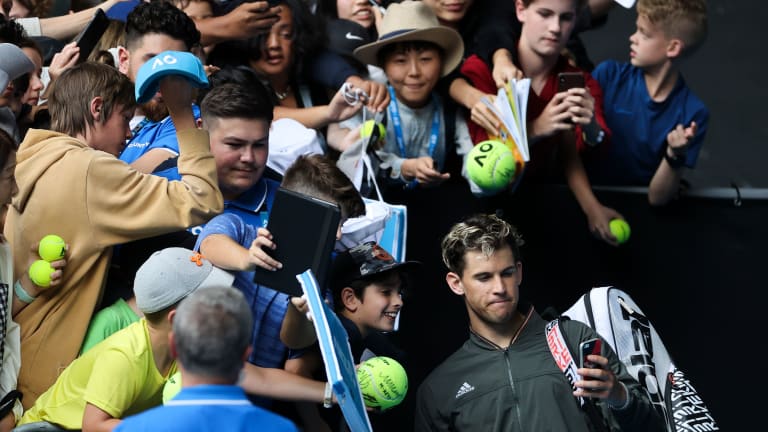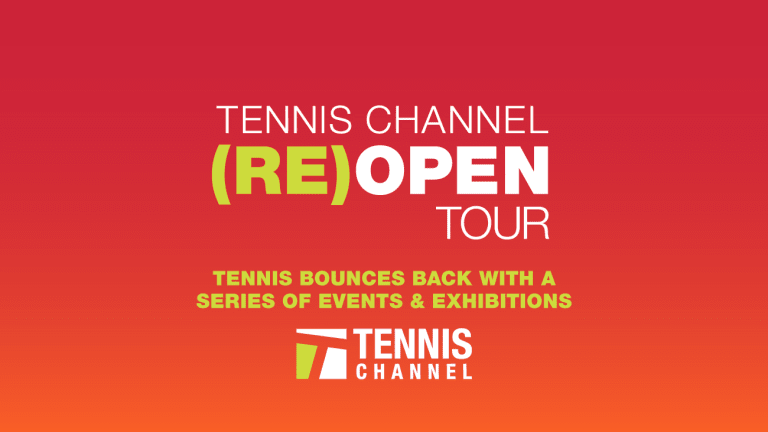The Rally: Is Dominic Thiem's player relief-fund reaction justifiable?
May 18, 2020Roger Federer and Caroline Wozniacki step out at the Masters: “So much tradition”
By Baseline Staff Apr 13, 2025Richard Gasquet given Monte Carlo wild card 20 years after breakthrough win over Roger Federer
By Ed McGrogan Apr 03, 2025Wolfgang Puck: The biggest tennis fan in the kitchen?
By Mitch Michals Mar 12, 2025Serena Williams, Roger Federer, Aryna Sabalenka and pickleball all featured during Super Bowl LIX
By Liya Davidov Feb 13, 2025Roger Federer’s Wimbledon-winning racquet sells for more than $100,000 in tennis auction
By Liya Davidov Feb 10, 2025Roger Federer explains tennis scoring, On logo to Elmo in Super Bowl ad
By Baseline Staff Feb 10, 2025Roger Federer’s Wimbledon winning racquet currently up for auction
By Liya Davidov Jan 28, 2025Henry Bernet, Australian Open junior champion, takes inspiration from fellow countrymen Roger Federer and Stan Wawrinka
By Associated Press Jan 25, 2025The best tennis fashion moments of 2024: Federer & Nadal for Louis Vuitton, Kostyuk's viral Wimbledon dress and more
By Stephanie Livaudais Dec 14, 2024The Rally: Is Dominic Thiem's player relief-fund reaction justifiable?
The world No. 3's comments brought to light a question that has been hovering around this period of suspended play: How does tennis best determine compensation?
Published May 18, 2020
Advertising
Dominic Thiem’s relief-fund reaction: Selfish? Sensible? Some of both? In this week’s Rally, Steve Tignor and Joel Drucker discuss the difficulties in dealing with income inequality in an individual sport. Connect with Steve and Joel on Twitter by using the hashtag #MondayRally.
Joel,
“None of them are going to starve.” Will these be the words that Dominic Thiem is best known for in the future?
I have to say, I didn’t expect that type of reaction from Thiem, or any other big-name player, when Novak Djokovic suggested that the top-ranked men contribute up to $30,000 to help out players ranked from No. 200 to 700 during the coronavirus lockdown. But Thiem didn’t hold back.
“No tennis player is fighting to survive, even those who are much lower-ranked. No tennis player is going to starve,” Thiem said to Krone, a paper in his native Austria. “…I would rather give money to people or organizations that really need it.”
“There are many, many players who don’t put the sport above everything else and don’t live in a professional manner. None of us top players got anything handed to us, we all had to fight our way up. I don’t have the guarantee in any job that I will do well and earn lots of money.”
My first reaction to that quote was: Well, so much for the idea of revenue sharing or prize-money redistribution in tennis, both of which have been hot topics this spring.
My second reaction was to say that Thiem, who has earned just under $24 million in prize money during his career, could afford a one-time payment of $30,000, and still have enough left over to donate to COVID-19 victims.
My third reaction was to nod and admit that, as harsh as he sounded, Thiem made at least one undeniable point: There’s never going to be a guarantee of success, or even survival, in any career path. Not everyone can play in the NFL or for Real Madrid, or become a movie star. How many people should be able to make a living playing tennis? There’s no number that’s more correct or fair than any other. As Thiem implies, tennis players don’t get into the sport so they can hand over some of their prize money to the opponents they beat.

The Rally: Is Dominic Thiem's player relief-fund reaction justifiable?
© AFP via Getty Images
Advertising
Getty Images
Thiem has been criticized, and his critics make their own undeniable points. For every lower-ranked tennis player who, as he says, “doesn’t live in a professional manner,” there are plenty who work hard and take their careers seriously. The more important point, to me, is that no player, Thiem included, makes his money in a vacuum. He brings in spectators, especially at smaller events and those in his native Austria, where he will likely be paid a fee just to show up. But at a big tournament—a Grand Slam or a Masters 1000—few fans pay to see Thiem and Thiem alone.
Instead, they pay to be part of an event, to roam around and watch dozens of different pros, to join the international tennis circus for a day. Staging those events requires star athletes, but it also requires thousands of other people, from sponsors to umpires to security workers to media to food servers. And tournaments also require dozens of lower-ranked players, all of whom who need to be paid even if they lose early. When Roger Federer plays, 99 percent of the audience may be there to see him; but he still needs an opponent to beat.
Of course, Thiem could come back and say: “OK, so we need 128 men and 128 women in singles for a major tournament. Why do we need to support 700 players?”
At which point, I’ll turn it over to you, Joel. What was your reaction to Thiem’s reaction? And do you think revenue sharing and redistribution have a place in tennis? Is there a realistic way to help more people make a living playing the sport?
Tennis Channel Live, Part 1—A deep dive into growth of prize money in tennis:
The Rally: Is Dominic Thiem's player relief-fund reaction justifiable?
Advertising
Steve,
Certainly there was a tone-deaf quality to Thiem’s comments.
While tennis is but a sliver of this crisis, hundreds of aspiring players are being profoundly affected by the cancellation of events. There’s a brusque, Social Darwinism at play in what Thiem said that’s quite harsh. I’d like to think he could have said something a bit more nuanced. And maybe Thiem might have then announced where he was going to make his next charitable contribution.
Still, Thiem’s comments brought to light a question that has been hovering around this period of suspended play: How does tennis best determine compensation?
Four times a year, consumers flock to events with 128 players—be it as ticket buyers or viewers. Television networks provide rights fees. Sponsors get involved too. From all that revenue, tennis’ four majors create compensation for a number of players, including those who only play doubles.
But the rest of the year, tournaments are much smaller, often with room for just 32 singles players. Are the promoters convinced that’s all the public wishes to view? Or has the public spoken, as evidenced by thin crowds in the early rounds of these smaller tournaments? Can the players themselves generate interest? For that matter, what is the role of national associations in aiding a player’s ambitions? That can get complicated, twisted by confusing communiqués between player, parents, coaches, administrators.
It’s nice to see the likes of Novak Djokovic, Rafael Nadal, Roger Federer, and Andy Murray speak about their willingness to help other players. That will be helpful in the short term. But in the long term, it won’t address what I’ll call tennis’ visibility and engagement problem.
The top 1000 team sports players are identified by their institutional affiliation. I don’t recognize Nick Allegretti, but he is a member of the Super Bowl champion Kansas City Chiefs. I watch him play because his team holds my interest. And maybe has that happens I also get to know more about him.
But the sober truth is that a great many highly skilled tennis players—let’s say, any in the Top 500—are often blank slates. For until a tennis player has generated significant results and, even more importantly, frequent airtime, he or she is pretty much unknowable.
This is one reason, as just one solution, that I wish players at all tournaments—even during practice sessions—would have their last name spelled out on the back of their shirts. So even if I’m seeing No. 270 play at an ATP Challenger event, after watching him in action, I might be compelled to learn more about him and begin to build some kind of affinity.
That tiny tactic aside, I have no idea how to assess the way compensation in tennis should be determined. Lacking any kind of top-down, league structure, the history of Open tennis has instead been one of fiefdoms and singular pursuits; one sprawling gig economy.
What are your thoughts, Steve? Can we truly assess what players do to drive the sport’s economy? Is there a viable way to earn a living if you’re not in the Top 100? Should that exist? How far down the ranks should it go? This is a case where it’s incredibly hard to figure out the answers.
Tennis Channel Live, Part 2—Restructuring prize money:
The Rally: Is Dominic Thiem's player relief-fund reaction justifiable?
Advertising
Joel,
I thought Somdev Devvarman, a former pro from India, had some good thoughts on this subject in an interview he did with ESPN this week.
Increasing the number of players who make a living in tennis from 500 to 5,000? That’s, well, highly ambitious; I’m not even sure there are that many people trying to be pros right now. But Devvarman is right that pay distribution is a major issue for the game’s rank and file, and has been for a long time. I also like his focus on trying to get more players from different countries into the game’s upper echelon. Tennis is enriched by its global scope, and each of those countries is a potential new market. Theoretically, he’s right that top players will have to “be paid less” if the game is going to be made more equitable. But judging from Thiem’s reaction to forking over $30,000, making that happen won’t be as easy as it sounds. Tournament directors and sponsors also like to have those giant novelty checks, with giant amounts of money written on them, to give to the winners at the end of their events. Raising pay for first-round losers isn’t as sexy.
I’m in favor of greater equality in just about all aspects of life, and I’d like to see as many players do well on tour as possible. But as a fan, do you think it has any effect on the quality of the sport as a whole, Joel? I’m not sure I believe that, if more people can make a living playing tennis, that we’ll see more top-level young athletes choose to play it. I don’t think that’s why kids gravitate toward a sport in the first place. They dream of winning Wimbledon and holding up the trophy, not earning $40,000 for reaching the second round.
The last decade has been utterly dominated by half a dozen superstars. Yet by most measures—money, visibility, growth—it has been a successful era for tennis. Does that tell us that things are OK as they are, and that the sport is at its best when there are just a few superstars winning everything in sight? With its hierarchical ranking system and pyramidal tournaments, maybe tennis as it’s currently constructed is destined to be unequal.
Tennis Channel Live, Part 3—Revenue share of prize money:
The Rally: Is Dominic Thiem's player relief-fund reaction justifiable?
Advertising
Steve,
More than 20 years ago, Billie Jean King told me that if the Top 3 men and Top 3 women organized themselves properly, they could run the sport. I found that intriguing, so viscerally true that I then added that in a de facto way, those half-dozen pretty much already did, largely due to their frequent success and the way it defined the tennis marquee.
In any tennis generation, the literal pyramid-like structure of tournaments creates an environment where no more than 3-6 people generate arguably 90 percent of tennis’ marketplace attraction (particularly among casual fans). This was even true in the pre-Open era, when only a few amateurs earned significant under-the-table dollars. In large part, the same held true with the professional barnstormers.
This narrow triangle point of attraction was one reason why King advocated so ardently for making tennis a team sport through World Team Tennis. She saw it as way for communities to build sustained engagement with a franchise rather than a single player. Alas, that business model also ran into trouble when the star players commanded far more dollars than many team owners could afford.
But back to the hundreds—let’s momentarily pause at thousands—of skilled players seeking to make a living playing tennis. As a start, would a player who can now earn in excess $3 million for winning a major be willing to donate even ten percent of it to fuel a circuit of smaller events? Would the same hold true for players who just earned $60,000 for losing in the first round? Who should take the lead in this kind of subsidy—the player or the national association putting on the tournament that’s offering a total purse of more than $50 million? Is it logical to ponder smaller circuits taking place in the four Grand Slam nations?

The Rally: Is Dominic Thiem's player relief-fund reaction justifiable?
© Getty Images
Advertising
Getty Images
Then, let’s play this out, those 128 men and women entered in the US Open accept ten percent less compensation. We’ll wave a wand and create a 10-tournament circuit of what we’ll call AAA Pro Tennis, all played between New Orleans and Jacksonville, aimed at players ranked 150 to 300. Total prize money will be $5 million—or better yet, $4.5 million, as $500,000 will go to support another AAA circuit, for players 300 to 500.
So the AAA Pro Tennis event in New Orleans gets underway. Or would this event more logically thrive in a smaller city such as Shreveport? Can it make money? How will the promoter seek to engage with the local tennis community? Will ample fans be willing to attend? Will parking and tickets be affordable and accessible? And here we get back to my earlier mention of anonymity and players so often thinking that as long as they just play the game well, everything else will take care of itself.
Maybe now is the time to revolutionize the player participation paradigm. If I’m ranked outside the Top 100, I’m contacting tournaments and offering not just to play, but to become an ambassador of sorts for the event—far more aggressive engagement with autograph sessions, Pro-Ams, sponsor parties, interviews, personal blogs, social media. If more players per event were willing to do this, perhaps over time, those attending or considering attending the New Orleans (Shreveport?) tournament could well build a deeper affinity with various players and the tournament overall.
But getting players to make themselves more accessible—for their own good—might well be too revolutionary. As a Top 10 player once said about players who resist attending sponsor parties, “Some of the guys who bitch the most are the biggest losers who wouldn’t even be able to turn a living on the tour if the few big names weren’t attracting the big purses.” Arthur Ashe wrote those thoughtful words in 1973. Alas, tennis has a long history of tricky player engagement issues, often (but not always) with profound economic implications.

The Rally: Is Dominic Thiem's player relief-fund reaction justifiable?